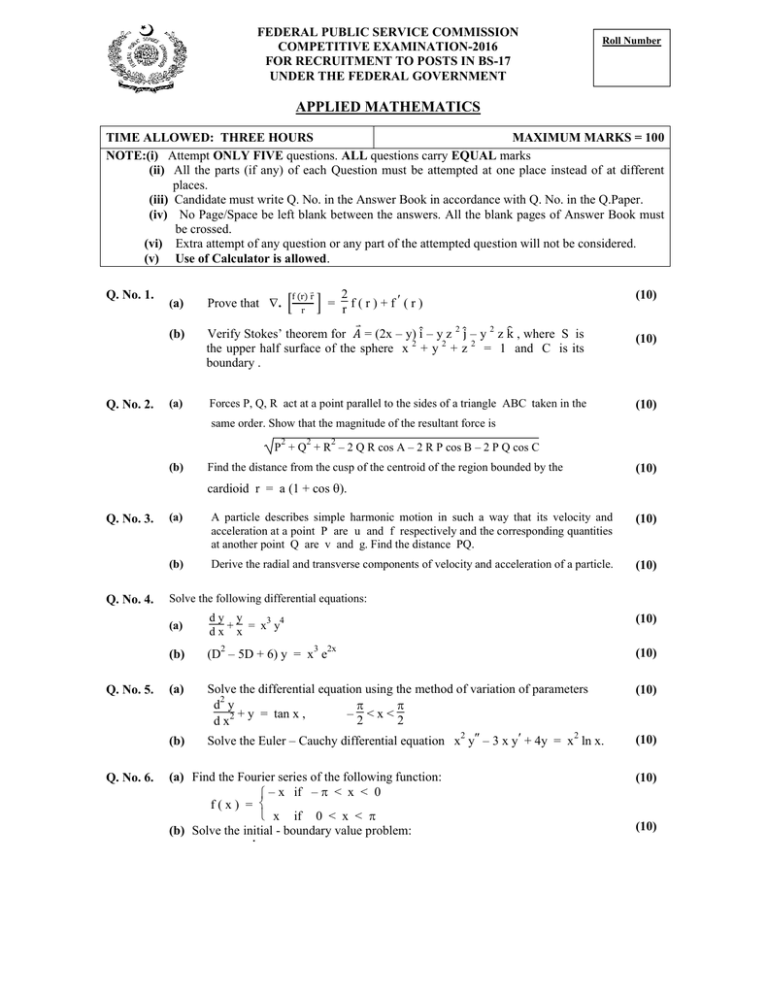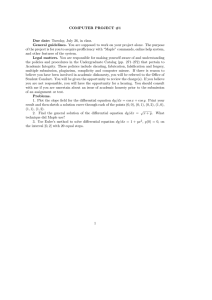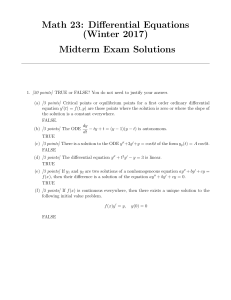applied mathematics
advertisement

FEDERAL PUBLIC SERVICE COMMISSION COMPETITIVE EXAMINATION-2016 FOR RECRUITMENT TO POSTS IN BS-17 UNDER THE FEDERAL GOVERNMENT Roll Number APPLIED MATHEMATICS TIME ALLOWED: THREE HOURS MAXIMUM MARKS = 100 NOTE:(i) Attempt ONLY FIVE questions. ALL questions carry EQUAL marks (ii) All the parts (if any) of each Question must be attempted at one place instead of at different places. (iii) Candidate must write Q. No. in the Answer Book in accordance with Q. No. in the Q.Paper. (iv) No Page/Space be left blank between the answers. All the blank pages of Answer Book must be crossed. (vi) Extra attempt of any question or any part of the attempted question will not be considered. (v) Use of Calculator is allowed. Q. No. 1. Q. No. 2. 2 = r f ( r ) + f ( r ) f(r)r⃑ (a) Prove that . (b) Verify Stokes’ theorem for ⃑ = (2x – y) i – y z 2 j – y 2 z k , where S is the upper half surface of the sphere x 2 + y 2 + z 2 = 1 and C is its boundary . (a) Forces P, Q, R act at a point parallel to the sides of a triangle ABC taken in the r (10) (10) (10) same order. Show that the magnitude of the resultant force is 2 2 2 P + Q + R – 2 Q R cos A – 2 R P cos B – 2 P Q cos C (b) Find the distance from the cusp of the centroid of the region bounded by the (10) cardioid r = a (1 + cos ). Q. No. 3. Q. No. 4. Q. No. 5. (a) A particle describes simple harmonic motion in such a way that its velocity and acceleration at a point P are u and f respectively and the corresponding quantities at another point Q are v and g. Find the distance PQ. (10) (b) Derive the radial and transverse components of velocity and acceleration of a particle. (10) Solve the following differential equations: (a) dy y 3 4 + = x y dx x (b) (D – 5D + 6) y = x e (10) (a) Solve the differential equation using the method of variation of parameters 2 d y + y = tan x , –2<x<2 d x2 Solve the Euler – Cauchy differential equation x2 y – 3 x y + 4y = x2 ln x. (10) (b) Q. No. 6. 2 (10) 3 2x (a) Find the Fourier series of the following function: – x if – < x < 0 f(x) = x if 0 < x < (b) Solve the initial - boundary value problem: 1 (10) (10) (10) APPLIED MATHEMATICS Q. No. 7. (a) Apply Newton – Raphson method to find the smaller positive root of the equation x2 – 4x + 2 = 0 (b) Solve the following system of equations by Gauss – Seidel iterative method by taking the initial approximation as x1 = 0, x2 = 0, x3 = 0: 5x1 + x2 – x3 = 4 x1 + 4x2 + 2x3 = 15 x1 – 2x2 + 5x3 = 12 1 Q. No. 8. (a) Approximate dx 2 using 1+x (10) (10) (10) 0 (i) Trapezoidal rule with n = 4 (ii) Simpson’s rule with n = 4 Also compare the results with the exact value of the integral. (b) Apply the improved Euler method to solve the initial – value problem: y = x + y, (10) y (0) = 0 by choosing h = 0.2 and computing y1, …, y5. ************* Page 2 of 2






